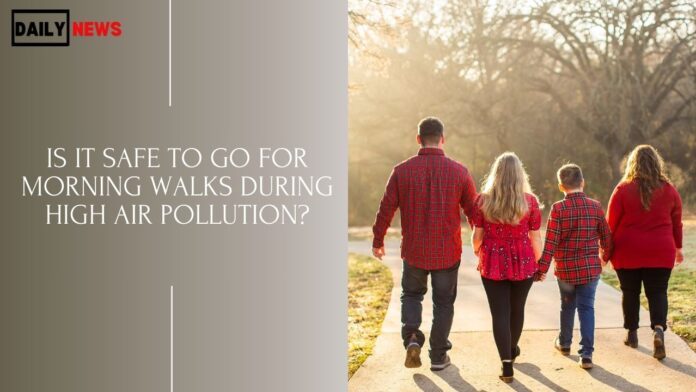Morning walks have long been regarded as a cornerstone of a healthy lifestyle. However, with rising levels of air pollution, the question arises: is it safe to continue this beneficial habit? While morning walks have numerous physical and mental health benefits, air pollution poses significant risks that must be carefully considered. This article delves into the potential dangers, mitigation strategies, and expert recommendations to ensure your health and safety during high pollution levels.
Understanding the Impact of Air Pollution on Health
Air pollution is a complex mixture of particulate matter (PM), nitrogen dioxide (NO₂), sulfur dioxide (SO₂), carbon monoxide (CO), and ground-level ozone (O₃). These pollutants can have severe health consequences, particularly for individuals with pre-existing respiratory or cardiovascular conditions.
Key Health Risks of Exposure to Air Pollution
- Respiratory Issues: Fine particulate matter (PM2.5 and PM10) can penetrate deep into the lungs, leading to conditions such as asthma, bronchitis, and even chronic obstructive pulmonary disease (COPD).
- Cardiovascular Problems: Prolonged exposure to polluted air can increase the risk of heart attacks, strokes, and hypertension due to systemic inflammation and oxidative stress.
- Weakened Immune System: Inhaling polluted air compromises the immune system, making the body more susceptible to infections.
- Long-Term Effects: Chronic exposure is linked to diseases such as lung cancer, diabetes, and even cognitive decline.
Why Morning Walks Can Be Riskier During High Pollution Levels
Many people believe that early morning air is fresher, but this is often a misconception in urban areas. Pollutant levels tend to accumulate overnight, and without sufficient wind to disperse them, mornings can be one of the worst times to venture outdoors.
Factors Contributing to Higher Pollution Risks in the Morning
- Temperature Inversions: During cooler nights, warmer air traps pollutants close to the ground, leading to higher concentrations of harmful particles.
- Traffic Emissions: Early morning traffic, including industrial and vehicular emissions, contributes to rising pollution levels.
- Low Wind Speeds: Calm conditions during the early hours prevent the dispersion of pollutants.
When Should You Avoid Morning Walks?
To ensure your safety, it’s essential to monitor local air quality levels. Air Quality Index (AQI) is a standardized measure that provides real-time information about pollution levels.
AQI Levels and Their Implications
- Good (0-50): Air quality is safe; morning walks are encouraged.
- Moderate (51-100): Generally safe, but sensitive groups should take precautions.
- Unhealthy for Sensitive Groups (101-150): People with respiratory or cardiac conditions should avoid outdoor activities.
- Unhealthy (151-200): Everyone should minimize prolonged or intense outdoor exertion.
- Very Unhealthy (201-300): Outdoor activities should be avoided entirely.
- Hazardous (301+): Stay indoors with air purifiers.
Precautions to Take During Morning Walks in Polluted Areas
While skipping your morning walk might seem like the safest choice, there are ways to mitigate risks and continue your routine with some adjustments.
1. Check the AQI Before Heading Out
Use reliable apps or websites to monitor real-time AQI levels in your area. If the AQI is above 150, it’s advisable to stay indoors.
2. Wear a High-Quality Mask
Invest in an N95 or KN95 mask, which can filter out fine particulate matter and reduce the inhalation of harmful pollutants.
3. Choose the Right Location
Avoid busy roads and industrial areas. Opt for parks, gardens, or spaces with dense greenery, which can act as natural air purifiers.
4. Time Your Walks Wisely
If mornings are highly polluted, consider walking during the afternoon when pollutant levels might be lower. Early evening can also be an alternative, but always recheck AQI levels.
5. Shorten Your Walk Duration
Limit your exposure by reducing the time spent outdoors. A 15-20 minute brisk walk can still offer health benefits without prolonged exposure to pollutants.
6. Stay Hydrated
Drinking plenty of water helps flush out toxins from the body and reduces the effects of pollutants.
Alternatives to Outdoor Morning Walks
If pollution levels are consistently high, there are indoor alternatives to maintain your fitness routine:
- Treadmill Workouts: A treadmill provides an excellent indoor substitute for walking or jogging.
- Yoga and Stretching: Low-impact exercises like yoga improve flexibility, strength, and mental well-being without exposing you to outdoor pollutants.
- Aerobic Classes: High-intensity indoor exercises can replace the cardiovascular benefits of morning walks.
- Cycling Indoors: A stationary bike is another effective option to keep your heart rate up.
The Role of Long-Term Solutions
While individual actions can reduce immediate risks, addressing air pollution requires a collective effort. Here are some measures that can contribute to long-term improvements:
- Advocating for Cleaner Energy: Support policies that promote renewable energy sources like solar and wind.
- Reducing Vehicle Emissions: Carpooling, public transportation, and electric vehicles can significantly reduce pollution.
- Planting Trees: Trees act as natural air filters by absorbing pollutants and releasing oxygen.
- Using Air Purifiers: Indoors, high-efficiency particulate air (HEPA) filters can improve air quality.
- Raising Awareness: Educating communities about the health risks of pollution and the importance of sustainable practices.
Conclusion
While morning walks are beneficial for overall health, high air pollution levels can negate these advantages and even pose severe risks. By staying informed about AQI levels, taking necessary precautions, and exploring alternative options, you can protect your health without compromising on your fitness goals. Additionally, contributing to long-term solutions can help create a cleaner, healthier environment for everyone.

Er. Rishav Raj (Btech Computer Science)
Dr. Rishav Raj (Bachelor of Ayurvedic medicine and Surgery)
I am a professional blogger since 12 years worked for different healthcare blog as well as health care advisor for different multinational companies as well as Software developer for different healthcare and technology based software.i am here to share you some informative blog regarding news , healthcare and technology







